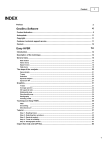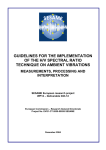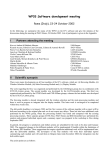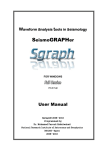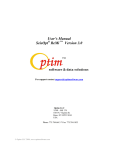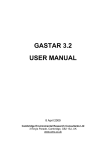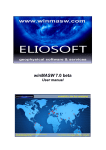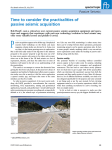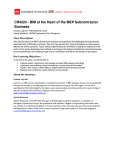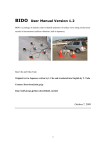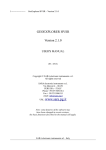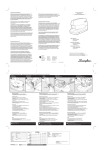Download Multi-platform H/V processing software J
Transcript
Site Effects Assessment Using Ambient Excitations SESAME European Commission – Research General Directorate Project No. EVG1-CT-2000-00026 SESAME WP03 - H/V Technique: Data Processing Report on the Multiplatform H/V Processing Software J-SESAME WP03 Deliverable D09.03 Department of Earth Science, University of Bergen Allegt.41, N-5007 Bergen, Norway Tel: +47-55-583600 Fax: +47-55-5836660 E-mail: [email protected] June 2003 SESAME WP03 Deliverable D09.03 List of Contents Summary ........................................................................................................................................................... 2 Chapter 1: Introduction...................................................................................................................................... 3 Chapter 2: The general design of the software .................................................................................................. 3 Chapter 3: Browsing Module ............................................................................................................................ 3 Chapter 4: Window Selection Module .............................................................................................................. 4 Chapter 5: Processing Module........................................................................................................................... 5 Chapter 6: Display Module ............................................................................................................................... 8 Acknowledgements ........................................................................................................................................... 9 FIGURES ........................................................................................................................................................ 10 APPENDIX I ................................................................................................................................................. 18 J-SESAME USER MANUAL (Ver. 1.05) ..................................................................................................... 18 APPENDIX II................................................................................................................................................ 30 SESAME ASCII Format (SAF) ..................................................................................................................... 30 APPENDIX III .............................................................................................................................................. 35 Example input file for the H/V processing ...................................................................................................... 35 List of Contributors (in alphabetical order after the last name) Kuvvet Atakan Pierre-Yves Bard Bladimir Moreno Pedro Roquette Alberto Tento Project coordinator: Task A Leader: WP03 Leader: UiB, Bergen, Norway LGIT, Grenoble, France UiB, Bergen, Norway (now at CENAIS, Santiago de Cuba, Cuba) ICTE/UL, Lisbon, Portugal CNR, Milano, Italy Pierre-Yves Bard, LGIT, Grenoble, France Kuvvet Atakan. UiB, Bergen, Norway Kuvvet Atakan, UiB, Bergen, Norway Contact address: Kuvvet Atakan Department of Earth Science, University of Bergen Allegt.41, N-5007 Beregn, Norway Tel: +47-55-583600 Fax: +47-55-583660 E-mail: [email protected] Summary In the following, we describe a new software solution (J-SESAME) to be used in H/V spectral ratio technique, which was developed under the framework of the SESAME Project (Site Effects Assessment Using Ambient Excitations, EC-RGD, Project No. EVG1-CT-2000-00026 SESAME), Task A (H/V Technique), Work Package 03 (WP03 – H/V Technique: Data Processing). Within the framework of the SESAME Project one of the work packages is devoted to the development of robust software for data analysis applying the H/V technique. The main goal of the Work Package 3 (WP03) is to develop a multiplatform processing software to be used as a standard procedure in processing the microtremor data using H/V technique. In the J-SESAME, existing algorithms that are used in the H/V data processing are tested and an optimum solution is applied for the computations. A user-friendly graphical interface is implemented to allow organizing and browsing the waveform data files easily coupled with several optional display and output functions. J-SESAME also provides default parameter settings for the different options of the software, which makes sure that the processing is conducted applying the optimum values. 17-02-04 16:56 pg. 2 of 37 SESAME WP03 Deliverable D09.03 Chapter 1: Introduction A significant part of damage during strong or moderate ground shaking is associated with local site effects. Detailed assessment of site effects and the predominant frequencies on which significant amplification occurs can be obtained using empirical or analytical techniques. Among the empirical techniques, the H/V spectral ratio of the ambient vibrations (microtremors), has been widely used in microzonation studies due to its cost-effective nature. Within the framework of the SESAME Project one of the work packages is devoted to the development of robust software for data analysis applying the H/V technique. The main goal of the Work Package 3 (WP03), is to develop a multiplatform processing software (J-SESAME) to be used as a standard procedure in processing the microtremor data using H/V technique. All existing software that was previously used in processing the microtremor data using the H/V technique are tested and an optimum solution for the analysis is deduced. The J-SESAME software is developed using the Java Programming Language, for multiplatform operation capacity. In addition the J-SESAME is designed using a modular concept for the different parts, allowing flexibility for further developments. The user is guided through the browsing module (i.e. graphical user interface, GUI) of the software and the window selection and the processing modules provide the input data selection and computation of the H/V spectral ratios. The display module is then responsible for producing visualization of the processed data in an easy and flexible way. This modular development also allows utilizing the best possible solution for the programming language to be used. In the case of the window selection and processing modules, the software codes are in Fortran, whereas the browsing and the display modules are developed using the Java Programming language. In the following, the general design of the software, its functionalities, and the different modules are explained in detail. A short user manual is also prepared and is included as a separate document in the appendix (see Appendix I). Chapter 2: The general design of the software The general design of the J-SESAME is based on a modular architecture as shown in Figure 1. There are basically four main modules: the browsing module, window selection module, processing module and the display module. The main functionalities are integrated through a graphical user interface, which is part of the browsing module. The display module is also tightly connected to the browsing module, as there is close interaction between the two modules due to the integrated code development in Java. The window selection and H/V processing modules act independently and are called from the browsing module to perform specific computations based on user defined optional parameters. The flowchart of the main processing in the JSESAME software is shown in Figure 2. The location of the software codes and the different parameter files, as well as the output is organized set by the user through the general configuration parameter settings, which is included under the “config” pull-down menu. The parameter default values for different options of the software are also organized under the same menu with relevant titles. The user is expected to check the default values, which are shown and (if not satisfied) the user is then requested to change them with the desired values. Once the appropriate parameter values are chosen, they will be applied for the remaining computations. In the present version two waveform file formats are supported: GSE and SAF (see Appendix II: SESAME ASCII Format). In the following chapters, each the four main modules are explained in detail. Chapter 3: Browsing Module Browsing module is entirely developed in Java, which is based on a graphical user interface that communicates with the window-selection and processing modules. The processed data is then visualized through the display module for manual inspection and different output options are provided (Figure 3). The main philosophy of the browsing module is to organize the data in individual projects. For each project, the corresponding waveform files are kept in a directory structure and is accessed through the configuration 17-02-04 16:56 pg. 3 of 37 SESAME WP03 Deliverable D09.03 parameters, which keeps the filenames associated with this project with full path description on the computer. In addition, the processing parameters that are used in each project are kept in the same project file under the configuration options. After defining a new project, the user creates different sites under which the corresponding data collected for each site are archived in the configuration as a tree-structure (i.e. each project contains several sites and each site contains several data files). This process allows the user to organize the data into individual sites easily by dragging on the directory structure or by inserting several files into each site using the mark and copy options (Figure 4). The default parameters for processing can then be displayed through the pull-down menu under the configuration (and if desired can be changed) and the entire project can be saved as a “project file”. A saved project can be uploaded (with the same configuration and parameter settings) for later usage. Once the data are organized under the project structure, the user then has the possibility to plot the waveform files (three components on the screen) for manual inspection. After the visual inspection, based on user defined (or default) parameters, user can select the time-windows either automatically or manually using the window selection module. The selected windows are then processed by the H/V processing module either as a single file or as a series of files usually corresponding to the same site. The H/V spectral ratios and the averages as well as other display options are then plotted using the display module. In case there is difficulty in selection windows automatically due to transients or other problems in the data (such as spikes), there are filter options, where the user can apply either low-pass, high-pass or band-pass filter. The filtered traces are then displayed to the user for window selection. In this process, a comparison is also made between the windows selected both on the filtered and on the unfiltered trace. The common windows are then used for further processing. Naturally, only the original unfiltered traces are used for the H/V ratios. This filtering option allows the user to work also with difficult data sets. The display module conducts the different plotting options, however, this process is not transparent to the user. The only thing the user has to do is to click on the output display button when the processing is completed (for the details of the display options see the following chapters). The different outputs are displayed through a series of windows. Chapter 4: Window Selection Module Besides the manual selection directly from the screen, which is often the most reliable, but also the most time consuming, an automatic window selection module has been introduced in view of processing large amounts of data. The objective is to keep the most stationery parts of noise, and to avoid the transients often associated with specific sources (walks, close trafic). This objective is exactly the opposite of the usual goal of seismologists who want to detect signals, and have developed specific "trigger" algorithm to track the unusual transients. As a consequence, we have used here an "antitrigger" algorithm, which is exactly the opposite: it detects transients but it tries to avoid them. The procedure to detect transients is very classically based on a comparison between the short term average "STA", i.e., the average level of signal amplitude over a short period of time, denoted "tsta" in the (typically around 0.5 to 2.0 s), and the long term average "LTA", i.e., the average level of signal amplitude over a much longer period of time, denoted "tlta" (typically several tens of seconds). When the ratio sta/lta exceeds an a priori determined threshold (typical values are between 3 and 5), then an "event" is detected. In our case, we want to select windows without any energetic transients: it means that we want the ratio sta/lta to remain below a small threshold value smax (typically around 1.5 – 2) over a long enough duration. Simultaneously, we also want to avoid noise windows with anomalously low amplitudes: we therefore also introduce a minimum threshold smin, which should not be reached throughout the selected noise window. There are also two other criteria that may be optionally used for the window selection: • one may wish to avoid signal saturation – as saturation does affect the Fourier spectrum. As gain and maximum signal amplitudes are not mandatory in the SAF and GSE formats, the program looks for the maximum amplitude over the whole noise recording, and automatically excludes 17-02-04 16:56 pg. 4 of 37 SESAME WP03 • Deliverable D09.03 windows during which the peak amplitude exceeds 99.5 % of this maximum amplitude. By default, this option is turned on. in some cases, there might exist long transients (for instance related to heavy traffic, trains, machines, …) during which the sta/lta will actually remain within the set limits, but that may be not representative of real seismic noise. Another option has therefore introduced to avoid "noisy windows", during which the lta value exceeds 80% of the peak lta value over the whole recording. By default, this option is turned off. The program automatically looks for time windows satisfying the above criteria; when one window is selected, the program looks for the next time window, and allows two subsequent windows to overlap by a specified amount "roverlap" (default value is 20%). It has been written as an independent Fortran subroutine, for which: • The input parameters are the selection parameters (tsta = sta window length; tlta = lta window length; [smin, smax] = lower and upper allowed bounds for the sta/lta ratio; tlong = noise window length over which the sta/lta should remain within the bounds; yes/no (1/0) parameters for turning on or off the saturation and "noisy window" options; overlapping percentage allowed for two subsequent windows) • The output parameters are a file with the noise file name, the begin and end times of each selected window, the recording status of each component : the main processing module then reads this file, and performs the H/V computation over each selected window. Chapter 5: Processing Module Main processing module is developed in FORTRAN90. It conducts H/V spectral ratio computations and the other associated processing such as DC-offset removal, filtering, smoothing, merging of horizontal components, etc., on the selected windows for individual files or alternatively on several files as a batch process. The instrument response is assumed to be removed by the user (in the case of identical components H/V ratios should not be affected by the instrument response). Main functionalities of the processing module are described below: • • • • • • • FFT (including tapering) Instrument response removal (not implemented) Smoothing with the following options o Konno & Ohmachi o Moving average o Linear o Triangle window Merging two horizontal components with the following options o No merging o Arithmetic mean o Geometric mean o Quadratic mean o Complex merging H/V Spectral ratio Average of several (H/V) ratios Error estimates on spectral ratios The parameter setting for the above options are controlled through an input file. For the details see the Appendix III. In the following a summary of the options for the H/V processing is given. 17-02-04 16:56 pg. 5 of 37 SESAME WP03 Deliverable D09.03 1) frequency spacing for output of H/V: The idea of this option is to specify a smaller sampling in the frequency domain, than the one determined from the Fourier transform, as much of the information becomes redundant after the smoothing. Other reasons are a better representation on a log scale or better comparison with other results, which were differently sampled. syntax: freq_spacing=<type>:<arg1>:<arg2>[:<arg3>] type fft fft_red linear log arg1 f_min f_min f_min arg2 f_max f_max f_max arg3 # points # points example: freq_spacing=log:1:10:4 The H/V ratio will then be output for the frequencies 1 2.15 4.64 and 10. The values of f_min and f_max are positive real numbers, values given in Hertz, f_min has to be smaller than f_max. the number of points (# points) has to be a positive integer. 2) offset removal Currently we only foresee the option for offset removal or no offset removal. Maybe later on we can add a high-pass filtering Syntax: offset_rem=<type>[:<arg>] type: r_mean high-pass: frequency example: offset_rem=r_mean The offset is removed The value of frequency for the high-pass filter is a positive real number, the value should be given in Hertz. 3) tapering window for Fourier Transform syntax: taper=<type>:[<arg1>] type arg1 arg2 boxcar cos percentage - arg3 - percentage of the window that is affected by the tapering on both ends example: taper=cos:10 The percentage is a positive real number, ranging between 0 (larger than 0) and 50. 4) instrument response correction 17-02-04 16:56 pg. 6 of 37 SESAME WP03 Deliverable D09.03 Currently the instrument response correction will operate on the single time window, therefore it will be applied in the Fourier domain by multiplication. syntax: instrument_resp=<arg> where arg is either 'yes' or 'no' example: instrument_resp = yes 5) smoothing of spectra syntax: smooth=<type>:[<arg1>[:<arg2>]] type arg1 arg2 none linear bandwidth box linear smoothing with constant weight in the interval [f-bw/2 f+bw/2] linear bandwidth tri linear smoothing with triangular weight in the interval [f-bw/2 f+bw/2] log percentage box smoothing with constant weight in an interval [f*(1-p/100) f*(1+p/100)] log percentage tri smoothing with triangular weight in an interval [f*(1-p/100) f*(1+p/100)] konno-ohmachi b-value - b-value for the smoothing window as defined in the Konno-Ohmachi article example: smooth=log:10:tri Each spectrum is smoothed on a logarithmic scale with bandwith 10 percent and triangular weighting The value of the bandwidth is a positive real number in Hertz. The percentage is a positive real, with units ‘%’, common values would be eg. 5 or 10. The Konno-Ohmachi b-value is defined in Konno and Ohmachi (1998), BSSA Vol 88, pp228-241, and it has positive values, eg. 10, 20 or 30. 6) merging of horizontal components syntax: merge_type=<type> type arithmetic geometric quadratic (H_ew+H_ns)/2 sqrt(H_ew*H_ns) sqrt(H_ew^2+H_ns^2) 7) output of H/V for the single components syntax: single_component=<arg> arg: 'yes' or 'no' If yes is selected, the output file will contain the columns frequency, average H/V, error, average H_ns/V, error, average H_ew/V, error If no is selected, the output file will contain only the columns frequency, average H/V, error 8) type of averaging the multiple windows syntax: average_type=<type> 17-02-04 16:56 pg. 7 of 37 SESAME WP03 Deliverable D09.03 type: linear log 9) output of single window information syntax: single_win_out=<arg> arg is either 'yes' or 'no' In case of 'yes', for each time window a separate output file is created. The name of the file is the base output file name extended by '_win_###', ### indicating the number of the time window in the sequence of file#2. Each file contains the columns frequency, spectrum vertical, spectrum NS, spectrum EW, merged H/V, H/V ns, H/V ew Chapter 6: Display Module The ‘Display Module’ was developed using the Java programming language. During the preparations interactions were made with groups working on the main processing module to coordinate the data input and output. In the following, the main functionalities of the display options are given. • • • • • • • • In general zooming is possible on all plots by left mouse button click and drag. Clicking once on the plot with left mouse button returns back to original trace. Right hand button of the mouse is used for highlighting a selected window. Clicking once again will give the option of deleting the window (available only in the browsing module). In the output window the title used is the name of the output file (Figure 5). In the output window all processing parameters present in the parameter file are shown (Figure 5). A legend that shows the meaning of each of the curves (Figures 5-7). It is possible to change the settings of each chart by clicking on the small box on the upper right corner. The settings include: o The colours o The line patterns and thickness o Showing (or not) the chart gridlines o Showing (or not) box axis o The font properties of the various fonts o Which curves to show o Saving format options The windows are resizable. User option to change between logarithmic and linear scales. The user is also able to change the limits in the scale. 17-02-04 16:56 pg. 8 of 37 SESAME WP03 Deliverable D09.03 Acknowledgements This project (Project No. EVG1-CT-2000-00026 SESAME) is supported by the European Commission – Research General Directorate. Apart from the authors of this report, a number of individuals have provided valuable contributions at different stages of the development. We thank Paula Teves-Costa (ICTE/UL, Lisbon), Jean-Luc Chatelain and Bertrand Guillier (RD, LGIT, Grenoble), and Jens Havskov (UiB, Bergen) for constructive suggestions, to Fabrizio Cara (INGV, Rome), Anne-Marie Duval (CETE, Nice) for testing the earlier version and suggesting the default parameter values. We also thank Fortunat Kind (ETH, Zurich) who has contributed to the development of the processing module during the initial stages. Finally, we thank all the SESAME project participants from the different participating institutions, who have contributed to JSESAME in different ways. Appendix I: J-SESAME User Manual (Ver.1.05) Appendix II: SESAME ASCII Format (SAF) Appendix III: Example input parameter file for H/V processing This deliverable (including the report, figures and appendices) is available on a CD, which can also be downloaded from the anonymous ftp site of the University of Bergen at the following address: ftp://ftp.ifjf.uib.no/pub/sesame/REPORT/WP03/DELIVERABLE/ 17-02-04 16:56 pg. 9 of 37 SESAME WP03 Deliverable D09.03 FIGURES 17-02-04 16:56 pg. 10 of 37 SESAME WP03 Deliverable D09.03 Project Acronym: SESAME Project Title: Site Effects Assessment Using Ambient Excitations Supported by: The European Commission – Research General Directorate Project No: EVG1-CT-2000-00026 SESAME Report Title: Multiplatform H/V Processing Software: J-SESAME, University of Bergen, Norway. WP03 H/V Technique: Data Processing. Deliverable No: D09.03 Projects: File-structure Window Selection Module H/V Spectral ratio Main processing module Interactive Single Trace Browsing Module Input Files and Parameters Display Module Display of Raw Data Batch Several Traces Display of Results Figure 1 : The general design of the J-SESAME Software. The four main modules are shown in bold. 17-02-04 16:56 pg. 11 of 37 SESAME WP03 Deliverable D09.03 Project Acronym: SESAME Project Title: Site Effects Assessment Using Ambient Excitations Supported by: The European Commission – Research General Directorate Project No: EVG1-CT-2000-00026 SESAME Report Title: Multiplatform H/V Processing Software: J-SESAME, University of Bergen, Norway. WP03 H/V Technique: Data Processing. Deliverable No: D09.03 Browsing Module Local Storage Filelist.inp Winparameter.inp Project_files in a directory structure including the configuration parameters (i.e. File_names and path of input waveforms; File_names for output Filter YES Filtertemp sesame.txt NO Filter the trace “Filename_out”_ SAF_fi Window Selection Module Winselection.out HVprocess.inp H/V Processing Module Numerical output files Display Module Graphical output files Figure 2 : Flowchart of the main processing in the J-SESAME software. 17-02-04 16:56 pg. 12 of 37 SESAME WP03 Deliverable D09.03 Project Acronym: SESAME Project Title: Site Effects Assessment Using Ambient Excitations Supported by: The European Commission – Research General Directorate Project No: EVG1-CT-2000-00026 SESAME Report Title: Multiplatform H/V Processing Software: J-SESAME, University of Bergen, Norway. WP03 H/V Technique: Data Processing. Deliverable No: D09.03 Figure 3: The general layout of the J-SESAME graphical user interface. 17-02-04 16:56 pg. 13 of 37 SESAME WP03 Deliverable D09.03 Project Acronym: SESAME Project Title: Site Effects Assessment Using Ambient Excitations Supported by: The European Commission – Research General Directorate Project No: EVG1-CT-2000-00026 SESAME Report Title: Multiplatform H/V Processing Software: J-SESAME, University of Bergen, Norway. WP03 H/V Technique: Data Processing. Deliverable No: D09.03 Figure 4 : The different pull-down menu’s of the J-SESAME for project description, parameter configuration and processing. 17-02-04 16:56 pg. 14 of 37 SESAME WP03 Deliverable D09.03 Project Acronym: SESAME Project Title: Site Effects Assessment Using Ambient Excitations Supported by: The European Commission – Research General Directorate Project No: EVG1-CT-2000-00026 SESAME Report Title: Multiplatform H/V Processing Software: J-SESAME, University of Bergen, Norway. WP03 H/V Technique: Data Processing. Deliverable No: D09.03 Figure 5 : The display options of the J-SESAME. Average H/V spectral ratio for the merged horizontal component with standard deviation are shown in diferent colors. 17-02-04 16:56 pg. 15 of 37 SESAME WP03 Deliverable D09.03 Project Acronym: SESAME Project Title: Site Effects Assessment Using Ambient Excitations Supported by: The European Commission – Research General Directorate Project No: EVG1-CT-2000-00026 SESAME Report Title: Multiplatform H/V Processing Software: J-SESAME, University of Bergen, Norway. WP03 H/V Technique: Data Processing. Deliverable No: D09.03 Figure 6 : Plotting options of the J-SESAME. Average of the individual H/V spectral ratios for the N-S and the E-W components (standard deviation is shown in different colors). 17-02-04 16:56 pg. 16 of 37 SESAME WP03 Deliverable D09.03 Project Acronym: SESAME Project Title: Site Effects Assessment Using Ambient Excitations Supported by: The European Commission – Research General Directorate Project No: EVG1-CT-2000-00026 SESAME Report Title: Multiplatform H/V Processing Software: J-SESAME, University of Bergen, Norway. WP03 H/V Technique: Data Processing. Deliverable No: D09.03 Figure 7 : The ploting options of the J-SESAME. The indicidual H/V spectral ratios (of the merged and the two horizontal components) for a selected time window (in red) is shown on the lower left diagram. The diagram on the lower right shows the spectra for the three components. 17-02-04 16:56 pg. 17 of 37 SESAME WP03 Deliverable D09.03 APPENDIX I J-SESAME USER MANUAL (Ver. 1.05) 17-02-04 16:56 pg. 18 of 37 SESAME WP03 Deliverable D09.03 JSESAME USER MANUAL Version 1.05 June 2003 Table of contents 1. Introduction 2. Requirements 3. Installation 4. Getting Started 5. Using JSEISAN 5.1.Configuration of the program 5.2.Creating a new project 5.3.Plotting data files 5.4.Selecting windows 5.4.Plotting filtered traces 5.5.Computing H/V spectral ratio 5.6. Showing output results 5.7. Setting graph properties and creating images of the output results 1. Introduction JSESAME is a JAVA application for providing a user-friendly graphical interface for H/V spectral ratio technique used in local site effect studies. The program uses the functions of automatic window selection and H/V spectral ratio by executing external commands. The automatic window selection and H/V process are standalone application developed in Fortran. JSESAME is mainly a tool for organizing the input data, execute window selection and processing, and display the processing results. The software operates in both Unix and Windows environments. 2. Requirements The following tool has to be installed in the Operating System: 9 Java Runtime Environment (JRE). You can download the files relevant for your operating system from the following web site: http://www.sun.com 3. Installation Two ZIP files are provided for Unix and Windows environments. The ZIP include three directories with the following files (Windows environment): In Hvprocess directory 17-02-04 16:56 pg. 19 of 37 SESAME WP03 Deliverable D09.03 hvproc0_1.exe : main processing module for H/V ratio hvsource.zip : source files In WindowSelection directory Winselection.exe : automatic window selection winsource.zip: source files In Jsesame directory jsesame.jar : java classes and source code jsesame.bat : script for executing the Java application “Jsesame” jsesame.pdf : user manual images : directory with tools-bar images 4. Getting started Once the ZIP file is uncompressed, user must open a Unix or DOS console, go to Jsesame directory and start the program from the prompt line as: jsesame Figure 1. Main window 5. Using JSESAME The user interaction with JSESAME (Figure 1) can be classified as: (1) Organizing the information, (2) processing the information and (3) displaying the results. The interface has a main window 17-02-04 16:56 pg. 20 of 37 SESAME WP03 Deliverable D09.03 where the user can create a new project or loaded an existing project, plot the traces on the screen, perform automatic or manual window selection, apply the H/V spectral ratio computations and see all the results in a user-friendly interface. Only two waveforms data format are accepted: GSE and SAF (SESAME ASCII Format). The extension of the data files is required to be one of these words (GSE or SAF). 5.1. Configuring the program JSESAME has several configuration variables to be set up by the user. In order to configure the variables, you have to click the item menu <Config> (Figure 2). The configuration parameters are shown in five dialog boxes. The first one is for configuring the automatic window selection (Figure 3), the second for the manual window selection, the third for the H/V processing module (Figure 4), the fourth for the filters parameters (Figure 5) and the last one for general configuration parameters (Figure 6). Note it is very important set the correct path for the window selection and processing module programs since they are external command call by JSESAME. Figure 2. Configuration menu 5.2. Creating a new project The structure of the project has a tree shape (Figure 1) where the data files are grouped by sites when several noise measurements are performed for a single location. Data files grouped in the “Unassigned_file” node are treated independently. That is the user has only one data file for each site. Each node in the tree has several parameters shown on the right side of the tree. The “Site name” and the “Output File name” parameters can be modified by the user. The changes are applied after pressing the RETURN key. Data file nodes can be dragged and dropped through the tree structure. For inserting new data files or sites and removing nodes from the project, users can press the corresponding button shown on the left site of the tree (Figure 1). The tree structure allow for multi-selection of nodes, which means that batch processing can be performed for several sites or individual data files. The project can be saved by using the item menu <project> (Figure 7) or by using the tools bar shown below the menu (Figure 1). 17-02-04 16:56 pg. 21 of 37 SESAME WP03 Deliverable D09.03 Figure 3. Automatic window selection parameters Figure 4. Processing module parameters for H/V spectral ratio 5.3. Plotting data files The highlighted or selected data-file can be plotted by pressing the button <Plot traces>. All the selected windows will be shown (Figure 8). Zooming can be done by clicking the left button of the mouse, then drag the mouse and release the button at the end of the selected time of the window. Clicking the left mouse button on anywhere on the plot will take you back to the original trace before zooming. 17-02-04 16:56 pg. 22 of 37 SESAME WP03 Deliverable D09.03 Figure 5. Filter options Figure 6. General parameters 5.4. Selecting windows Windows can be selected automatically or manually. The manual window selection can be done if the check-box labeled as “Manual window selection” (Figure 8) is active. The window is selected using the same procedure as zooming action. Individual windows can be removed by clicking the right button of the mouse twice: one click for selecting the window and another click for the deleting action. Automatic window selection can be performed in four different ways (Figure 9). The first one is applied to the original traces. The second is applied to the filtered trace with the filter selected in the <Config> option. The third is the common windows between the original and the filtered traces. The last option keeps the same selected windows of the first file for the rest of 17-02-04 16:56 pg. 23 of 37 SESAME WP03 Deliverable D09.03 the selected files. This option makes sense when the user highlights (select) a group of files from the project. Figure 7. Project options Figure 8. Zoomed traces with the selected windows 5.5. Plotting filtered traces The selected data-files can be filtered with the previous selected filter in the <Config> option (Figure 5) and then plotted on the screen. This option is available within the <Processing> menu item (Figure 9). The selected windows for the plotted data-file are also shown. Zooming on the filtered traces can be performed as explained in section 5.3. 17-02-04 16:56 pg. 24 of 37 SESAME WP03 Deliverable D09.03 Figure 9. Processing options 5.6. Computing H/V spectral ratio The processing module (option shown in Figure 9) is applied according to the selected nodes in the tree. If the selected node is a site, then all the selected windows of the data-files collected for this site will be used for computing the average H/V spectral ratio. Output for each window also can be obtained by setting up the configuration parameters of the processing module (Figure 4). Batch processing will be performed when several sites or data-files are selected. 5.6. Showing output results By pressing the <View Output> button (Figure 8) the user can navigate through three dialog boxes. The first dialog box (Figure 10) shows the H/V spectral ratio of the merged horizontal components. The second dialog box (Figure 11) shows the H/V spectral ratio for each one of the NS and EW components. The third one (Figure 12) shows the spectral ratio of the merged (H), NS and EW horizontal components and the spectra of Z, NS and EW for each individual window, if “output single window information” is selected in the configuration parameter of the processing module (Figure 4). To select an individual window the user has to click the right button of the mouse on it. Zooming action can be done over the spectrum using the same procedure explained in section 5.3. The individual values of the spectrum can be shown by clicking the middle button of the mouse over the spectral curve. 17-02-04 16:56 pg. 25 of 37 SESAME WP03 Deliverable D09.03 Figure 10. Spectral ratio for merged horizontal components 5.7. Setting graph properties and creating images of the output results For each graph shown in Figure 10,11 and 12 there is a small box in the upper right corner without any label. By clicking there the properties and scale of the graph can be modified and images of the graph can be created (Figure 13a). The button <Properties and series> pop up a dialog box (Figure 13b) where line type, width and colour (Figure 13c) can be changed for each spectral curve. The button <Scales> pop up a dialog box (Figure 13d) where the minimum, maximum and scale for each one of the vertical and horizontal axes can be modified. The button <Save> allows to create an image of the graph. 17-02-04 16:56 pg. 26 of 37 SESAME WP03 Deliverable D09.03 Figure 11. Spectral ratio for each NS and EW horizontal component 17-02-04 16:56 pg. 27 of 37 SESAME WP03 Deliverable D09.03 Figure 12. Result for individual windows Figure 13a. Graph properties Figure 13b. Selection of the components 17-02-04 16:56 pg. 28 of 37 SESAME WP03 Deliverable D09.03 Figure 13c. Properties of the Spectral curve Figure 13d. Scale properties for the spectral curve 17-02-04 16:56 pg. 29 of 37 SESAME WP03 Deliverable D09.03 APPENDIX II SESAME ASCII Format (SAF) 17-02-04 16:56 pg. 30 of 37 SESAME WP03 Deliverable D09.03 Format of the input waveform file: SESAME ASCII Format (SAF) The SESAME ASCII Format (SAF) file is organized in 3-columns (corresponding to 3-channels) and the parameters that must be included in the header are: -Station/Site code -Start date and time -Sampling frequency -Number of samples (data points) -Component-1 definition (i.e. to indicate which column refers to which channel) -Component-2 definition -Component-3 definition -Unit of the data points Key words and other details would have to be handled by the developers. Therefore the structure of such SESAME data file should be: - First line: "SESAME ASCII data format (saf) v. 1 " - Header information - Empty lines are allowed - Comments can be added provided that the first character in the row is "#" - Keywords are not case sensitive - Separator between keywords and their values is "=" - The order of the keywords is irrelevant - Blanks can be added everywhere - Data begin after this separator line: "####--------------------" - Data are written in three columns free format - Column 1 must correspond to the Vertical channel, columns 2 and 3 to the horizontal ones Mandatory keywords are : - STA_CODE : station/site code (In the GSE2.0 format this parameter is at most 5 characters long) - START_TIME : start date and time - year month day hour minute second (e.g. 1999 4 23 0 3 44.78 ) - SAMP_FREQ : sampling frequency in Hertz - NDAT : number of samples - CH0_ID : component 1 definition - It should be the vertical channel. It is a label. (In the GSE2.0 format this parameter is 3 characters long) - CH1_ID : component 2 definition - horizontal - CH2_ID : component 3 definition - horizontal - UNITS : label (e.g. m/s) Supposing that the horizontal components are at 90 degrees between each other, we still need to add an OPTIONAL parameter, which deals with sensor orientation. - NORTH_ROT : is the orientation of the first horizontal component (channel 1 - column 2) from North clockwise (degrees) 17-02-04 16:56 pg. 31 of 37 SESAME WP03 Deliverable D09.03 The following keywords/codes are available from the header: • reference code of the sensor response (instrument response file) • sampling_rate in Hertz (eg. 125Hz) • date and time: start time of the trace as accurate as possible • accuracy of timing • sensor type (accelerometer/seismometer) • instrument-ID digitizer (serial number) • instrument-ID sensor (serial number) • acquisition system • conversion factor: counts -> Volt (V/count) • transduction: Volt -> physical meaning (V/m/s) • units of data in file (counts, or whatever, just identifying it) • number of data points • comment line defining Vertical, NS, EW • saturation of digitizer • site code of exactly six characters (eg. BSL_12) • Station coordinates on separate lines, X,Y,Z • project name • arbitrary number of comment lines • separator line before the data • earthquake information as defined as for the Pitsa format In general the processing should be possible without most of the above information. But the following are strictly required: • sampling_rate in Hertz (eg. 125Hz) • number of data points • channel information is needed, but it is fixed in the format Although the instrument response information is not mandatory, the following two options may be of interest for the processing: • reference code of the sensor response (instrument response file) • saturation of digitiser in units of data The remaining options are recommended. Filenames of SESAME ASCII 1) free file name, extension of the name will be .saf, such that the format can be identified from the extension 2) The suggested filename contains site code, date and time: NNNNNN_yyyyMMdd_hhmm.saf 17-02-04 16:56 pg. 32 of 37 SESAME WP03 Deliverable D09.03 Following is an example of a SAF file: SESAME ASCII data format (saf) v. 1 (this line must not be modified) # The SESAME ASCII Format can contain an arbitrary number of comment # lines starting with '#' in the header. Parameters are specified on # lines starting without # character, followed by a keyword separated # with a '=' sign from the value of the key. The keyword name can be in # lower # or upper case letters, no distinction is made in the interpretation. # No empty lines are allowed in the header. # The first line indicates the name of the file format, # for automatic format identification tools. # # Two compulsory parameters have to be specified # the sampling rate and the number of points. # # All other parameters are optional, but the response and saturation # information # is highly recomended. # # Data begin after this line : "####--------------------------------" # Data are organized in colums in this order : Vertical, Horizontal_1, # Horizontal_2 # Horizontal_1 generally is N-S, for different orientation parameter # NORTH_ROT can # be set. # Data can be real or integer # # # sampling frequency in Hertz SAMP_FREQ = 125 # number of samples (integer) NDAT = 1200 # date and time of the first sample, read as 5 integers, one real START_TIME=2002 4 26 17 03 12.1233324 # accuracy of the timing, in seconds #very large values indicate manual time setting # GPS ~0.001, DCF ~0.01 TIME_ACCURRACY= 0.001 # Sensor type (accelerometer, seismometer) SENSOR_TYPE = accelerometer # Sensor serial number (character string) SENSOR_ID = Q332 # Sensor name (character string) SENSOR_NAME = Lennartz 5s # Response file code (name of the file in the response directory) RESPFILE = mark1s_098 # Acquisition system (character string) ACQ_SYSTEM = MARS88 # Digitizer serial number (interpreted as character string) DIGITIZER_ID = 345 # saturation value of the digitizer in UNITS SATURATION = 23056 # conversion factor ( V/count) CONV_FACTOR = 1234.5 # transduction factor (Volts/m/s or Volts/m/s^2) TRANS_FACTOR = 12345.6 # Eigen frequency of the sensor SENS_EIGFREQ = 1 # Damping factor of the sensor SENS_DAMPING = 0.7 # Code for the site (exactly 6 characters) 17-02-04 16:56 pg. 33 of 37 SESAME WP03 Deliverable D09.03 STA_CODE= NCE_12 # Station coordinate type, 0= lat/lon, 1= km of local coordinate, # elevation is always in km STA_COORD_TYPE = 0 # coordinates are one real number: 45 30' -> 45.5 STA_X = 45.73 STA_Y = 7.009 STA_Z = 0.235 # project name PROJECT_NAME = example data format project # # Earthquake data can be specified with the Pitsa keywords: # # Event coordinate type, as station coordinate type EVT_COORD_TYPE = 0 # Event location EVT_X = 34.5432 EVT_Y = 5.876 EVT_Z = 0.786 # Event time (origin time) EVT_TIME = 1989 3 23 17 4 12.345 # Event comment EVT_COMMENT = Lisbon quake # Station comment STA_COMMENT = bedrock # event azimuth (from north clockwise) EVT_AZ = 270 # event backazimuth (from north clockwise) EVT_BACK_AZ = 23.345 # event hypocentral distance (km) EVT_HYPO_DIST = 30 # event epicentral distance (km) EVT_EPI_DIST = 3000 # Event magnitude definitions: EVT_MAG = 7.3 # magnitude definitions with specific magnitudes # possible keys: EVT_LOCAL_MAG, EVT_BODY_MAG, EVT_SURFACE_WAVE_MAG, # EVT_DURATION_MAG, EVT_MOMENT_MAG # Orientation of Horizontal_1 component from North clockwise (degrees) NORTH_ROT # units of the values below in the data (label) UNITS = m/s # # Vert, NS, EW ####------------------------------------------------------13 214 898 13 214 898 13 214 898 13 214 898 13 214 898 13 214 898 13 214 898 13 214 898 13 214 898 13 214 898 13 214 898 13 214 898 13 214 898 13 214 898 13 214 898 13 214 898 13 214 898 13 214 898 13 214 898 17-02-04 16:56 pg. 34 of 37 SESAME WP03 Deliverable D09.03 APPENDIX III Example input file for the H/V processing 17-02-04 16:56 pg. 35 of 37 SESAME WP03 Deliverable D09.03 # example parameter file # lines starting with # character are comments # the following part of this file refers only to what will be processed by the min processing routine, # there will be further sections relating to the window selection or what ever. ### section processing ## possible options for frequency spacing # syntax: freq_spacing:<type>:<arg1>:<arg2>[:<arg3>] # # type arg1 arg2 arg3 # fft # fft_red f_min f_max # linear f_min f_max # points # log f_min f_max # points freq_spacing:log:0.1:25:800 ## possible options for offset removal # syntax # offset_rem:<type>[:<arg>] # type: # no # r_mean # high-pass: frequency offset_rem:high-pass:0.02 ## tapering # syntax: # taper:<type>:[<arg1>] # # type arg1 arg2 arg3 # boxcar # cos percentage the # # taper:cos:5 - percentage of the window that is affected by tapering on both ends ## instrument correction # syntax: # instrument_resp:<arg> # # where arg is either 'yes' or 'no' # instrument_resp:yes ## smoothing section # syntax: # smooth:<type>:[<arg1>[:<arg2>]] # # type arg1 arg2 # none # linear bandwidth box linear smoothing with constant weight in the interval [f-bw/2 f+bw/2] # linear bandwidth tri linear smoothing with triangular weight in the interval [f-bw/2 f+bw/2] # log percentage box smoothing with constant weight in an interval [f/(1+p/100) f*(1+p/100)] # log percentage tri smoothing with triangular weight in an interval [f/(1+p/100) f*(1+p/100)] 17-02-04 16:56 pg. 36 of 37 SESAME WP03 # konno-ohmachi bandwidth # smooth:konno-ohmachi:20 Deliverable D09.03 - bandwith for the smoothing window ## merging of horizontal components # syntax: # merge_type:<type> # # type # arithmetic (H_ew+H_ns)/2 # geometric sqrt(H_ew*H_ns) # quadratic sqrt(H_ew^2+H_ns^2) # merge_type: geometric ## output of single components # syntax: # single_component:<arg> # # arg: 'yes' or 'no' single_component:no ## average of horizontal components # syntax: # average_type:<type> # # type # linear # log average_type:log ## output of single window information] # syntax: # single_win_out:<arg> # # arg is either 'yes' or 'no' single_win_out:no ### end processing # maybe some further options not related to the processing 17-02-04 16:56 pg. 37 of 37





































